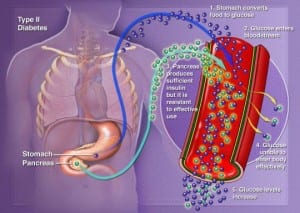Diabetes (Type 2)
Glucose is a type of sugar. It comes from food, and is also created in the liver. Glucose travels through the body in the blood. It moves from the blood to cells with the help of a hormone called insulin. Once glucose is in those cells, it can be used for energy.
Diabetes is a condition that makes it difficult for the body to use glucose. This causes a buildup of glucose in the blood. It also means the body is not getting enough energy. Type 2 diabetes is the most common type of diabetes.
Medication, lifestyle changes, and monitoring can help control blood glucose levels.
Copyright © Nucleus Medical Media, Inc.
This content was created using EBSCO’s Health Library
Type 2 diabetes is often caused by a combination of factors. One factor is that your body begins to make less insulin. A second factor is that your body becomes resistant to insulin. This means there is insulin in your body, but your body cannot use it effectively. Insulin resistance is often related to excess body fat.
This content was created using EBSCO’s Health Library
Type 2 diabetes is more common in people who are aged 45 years and older. It is also common in younger people who are obese and belong to at-risk ethnic groups. Other factors that increase your chance for type 2 diabetes include:
- Prediabetes—impaired glucose tolerance and impaired fasting glucose
- Metabolic syndrome—a condition marked by elevated cholesterol, blood glucose, blood pressure, and central obesity (a high concentration of body fat around the upper body and abdomen)
- Excess weight or obesity, especially central obesity
- Lack of exercise
- Poor diet—high intake of processed meats, fats, sugar-sweetened foods and beverages
- Family history of type 2 diabetes
- High blood pressure
- History of cardiovascular disease
- Depression
- History of gestational diabetes, or having a baby weighing over nine pounds at birth
- Endocrine disorders, such as Cushing’s syndrome, hyperthyroidism, acromegaly, polycystic ovary syndrome, pheochromocytoma, or glucagonoma
- Conditions associated with insulin resistance, such as acanthosis nigricans
- Certain medications, such as glucocorticoids or thiazides
- Certain ethnic groups, such as African American, Hispanic, Native American, Hispanic American, Asian American, or Pacific Islander
This content was created using EBSCO’s Health Library
You may have diabetes for years before you have symptoms. Symptoms caused by high blood sugar or include:
- Increased urination
- Extreme thirst
- Hunger
- Fatigue
- Blurry vision
- Irritability
- Frequent or recurring infections
- Poor wound healing
- Numbness or tingling in the hands or feet
- Problems with gums
- Itching
- Problems having an erection
This content was created using EBSCO’s Health Library
The doctor will ask about your symptoms and medical history. You will also be asked about your family history. A physical exam will be done. Diagnosis is based on the results of blood testing. American Diabetes Association (ADA) recommends a diagnosis be made if you have one of the following:
- Symptoms of diabetes and a random blood test with a blood sugar level greater than or equal to 200 mg/dL (11.1 mmol/L)
- Fasting blood sugar test is done after you have not eaten for eight or more hours—showing blood sugar levels greater than or equal to 126 mg/dL (7 mmol/L) on two different days
- Glucose tolerance test measures blood sugar two hours after you eat glucose—showing glucose levels greater than or equal to 200 mg/dL (11.1 mmol/L)
- HbA1c level of 6.5% or higher—indicates poor blood sugar control over the past 2-4 months
mg/dL = milligrams per deciliter of blood; mmol/L = millimole per liter of blood
This content was created using EBSCO’s Health Library
Treatment aims to:
- Maintain blood sugar at levels as close to normal as possible
- Maintain a healthy weight
- Prevent or delay complications
- Control other conditions that you may have, like high blood pressure and high cholesterol
After an initial evaluation your physical therapist will be able to create a rehabilitation program that takes into account both your goals as well as your physicians in regards to weight loss and exercise. A physical therapist can also help with certain complications of diabetes such as diabetic neuropathy (covered in the foot section of the injury center). Your physical therapy program may include:
- Aerobic exercises & resistance training: Both types of exercise help to improve long-term glucose control. Regular exercise can also help reduce your risk of heart disease.
- Patient education & information on exercise precautions
This content was created using EBSCO’s Health Library
To reduce your chances of developing type 2 diabetes:
- Participate in regular physical activity
- Maintain a healthy weight
- Drink alcohol in moderation (two drinks per day for a man, and one drink per day for a woman)
- Eat a well-balanced diet:
- Get enough fiber
- Avoid fatty foods
- Limit sugar intake
- Eat more green, leafy vegetables
- Eat whole fruits, especially apples, grapes, and blueberries
This content was created using EBSCO’s Health Library
This content was created using EBSCO’s Health Library Resources
- American Diabetes Association
http://www.diabetes.org
- National Diabetes Information Clearinghouse
http://diabetes.niddk.nih.gov
CANADIAN RESOURCES:
- Canadian Diabetes Association
http://www.diabetes.ca
- Public Health Agency of Canada
http://www.phac-aspc.gc.ca
REFERENCES:
- American Association of Clinical Endocrinologists, American College of Endocrinology. Medical guidelines for the management of diabetes mellitus. The AACe system of intensive diabetes self-management. 2002 update. Endocrine Practice. 2002;8(suppl 1):S40-82.
- American Diabetes Association Diagnosis and Classification of Diabetes Mellitus. Diabetes Care. 2010;33:S62-S69.
- Boren SA, Gunlock TL, Schaefer J, Albright A. Reducing risks in diabetes self-management: a systematic review of the literature. Diabetes Educ. 2007;33:1053-1077.
- Diabetes. National Center for Chronic Disease Prevention and Health Promotion, Centers for Disease Control and Prevention website. Available at: http://www.cdc.gov/nccdphp/publications/aag/ddt.htm Updated August 1, 2011. Accessed August 29, 2013.
- Diabetes basics—type 2. American Diabetes Association website. Available at: http://www.diabetes.org/diabetes-basics/type-2/?loc=HomePage-type2-tdt Accessed August 29, 2013.
- Diabetes. National Institute of Diabetes and Digestive and Kidney Diseases website. Available at: http://diabetes.niddk.nih.gov Updated July 10, 2013. Accessed August 29, 2013.
- Diabetes mellitus type 2. EBSCO DynaMed website. Available at: http://www.ebscohost.com/dynamed Updated July 29, 2013. Accessed August 29, 2013.
- Diagnosis and classification of diabetes mellitus. Diabetes Care. 2005;28(suppl 1):S37-42.
- Dietary considerations for patients with type 2 diabetes. EBSCO DynaMed website. Available at: http://www.ebscohost.com/dynamed Updated April 10, 2013. Accessed August 29, 2013.
- FDA approves new drug treatment for type 2 diabetes. US Food and Drug Administration website. Available at: http://www.fda.gov/NewsEvents/Newsroom/PressAnnouncements/ucm174780.htm Updated April 17, 2013. Accessed August 29, 2013.
- Gaede P, Vedel P, Larsen N, et al. Multifactorial intervention and cardiovascular disease in patients with type 2 diabetes. N Engl J Med. 2003; 248:383-393.
- Harsch IA. Inhaled insulins: their potential in the treatment of diabetes mellitus. Treat Endocrinol. 2005;4:131-138.
- Lee DC, Sui X, Church TS, Lee IM, Blair SN. Associations of cardiorespiratory fitness and obesity with risks of impaired fasting glucose and type 2 diabetes in men. Diabetes Care. 2009;32:257-262.
- Marre M. Reducing cardiovascular risk in diabetes. J Hypertens. 2007;(supp 11)S19-22.
- Physical activity/exercise and diabetes. Diabetes Care. 2004;27(suppl 1):S58-62.
- Rosenbloom AL, Silverstein JH, Amemiya S, et al. ISPAD Clinical Practice Consensus Guideline 2006-2007. Type 2 diabetes mellitus in the child and adolescent. Pediatr Diabetes. 2008;9:512-526.
- Rosenzweig JL, Ferrannini E, Grundy SM, et al. Primary prevention of cardiovascular disease and type 2 diabetes in patients at metabolic risk: an endocrine society clinical practice guideline. J Clin Endocrinol Metab. 2008;93:3671-3689.
- Skyler JS, Bergenstal R, Bonow RO, et al. Intensive glycemic control and the prevention of cardiovascular events: Implications of the ACCORD, ADVANCE and VA diabetes trials: a position statement of the American Diabetes association and a scientific statement of the American College of Cardiology Foundation and the American Heart Association. Circulation. 2009;119:351-7.
- Standards of medical care in diabetes—2009. Diabetes Care. 2009;32:S13-61.
- Statement by an AACE/ACE Consensus Panel on Type 2 Diabetes Mellitus: An Algorithm for Glycemic Control. Endocr Pract. 2009;15:540-559.
- Traina AN, Kane MP. Primer on pramlintide, an amylin analog. Diabetes Educ. 2011;37(3):426-431.
- UK Prospective Diabetes Study Group. Effect of intensive blood-glucose control with metformin on complications in overweight patients with type 2 diabetes. Lancet. 1998; 352:954-965.
- US Preventive Services Task Force: Screening for type 2 diabetes mellitus in adults: U.S. Preventive Services Task Force recommendation statement. Ann Intern Med. 2008;148:846-54.
- 11/29/2006 DynaMed Systematic Literature Surveillance. http://www.ebscohost.com/dynamed: Lindstrom J, Ilanne-Parikka P, Peltonen M, Aunola S, Eriksson JG, Hemio K, et al. Sustained reduction in the incidence of type 2 diabetes by lifestyle intervention: follow-up of the Finnish Diabetes Prevention Study. Lancet. 2006;368:1673-1679.
- 9/19/2006 DynaMed Systematic Literature Surveillance. http://www.ebscohost.com/dynamed: Thomas DE, Elliott EJ, Naughton GA. Exercise for type 2 diabetes mellitus. Cochrane Database of Syst Rev. 2006;CD002968.
- 6/1/2007 DynaMed Systematic Literature Surveillance. http://www.ebscohost.com/dynamed: Nissen SE, Wolski K. Effect of rosiglitazone on the risk of myocardial infarction and death from cardiovascular causes. N Engl J Med. 2007;356(24):2457-2471.
- 7/13/2007 DynaMed Systematic Literature Surveillance. http://www.ebscohost.com/dynamed: Farmer A, Wade A, Goyder E, et al. Impact of self-monitoring of blood glucose in the management of patients with non-insulin treated diabetes: open parallel group randomised trial. BMJ. 2007;335(7611):132.
- 12/13/2007 DynaMed Systematic Literature Surveillance. http://www.ebscohost.com/dynamed: Milman U, Blum S, Shapira C, et al. Vitamin E supplementation reduces cardiovascular events in a subgroup of middle-aged individuals with both type 2 diabetes mellitus and the haptoglobin 2-2 genotype. A prospective double-blinded clinical trial. Arterioscler Thromb Vasc Biol. 2008;28(2):341-347.
- 2/13/2008 DynaMed Systematic Literature Surveillance. http://www.ebscohost.com/dynamed: For safety, NHLBI changes intensive blood sugar treatment strategy in clinical trial of diabetes and cardiovascular disease. NIH News. National Institutes of Health website. Available at: http://www.nih.gov/news/health/feb2008/nhlbi 06.htm. Accessed August 29, 2013.
- 2/21/2008 DynaMed’s Systematic Literature Surveillance http://www.ebscohost.com/dynamed Major international diabetes study does not confirm increased risk of death reported by US trial. Action in Diabetes and Vascular Disease: PreteraAx and DiamicroN MR Controlled Evaluation (ADVANCE) website. Available at: http://www.advance-trial.com/static/html/virtual/contents.asp?P=39. Accessed August 29, 2013.
- 2/28/2008 DynaMed’s Systematic Literature Surveillance http://www.ebscohost.com/dynamed: Davies MJ, Heller S, Skinner TC, et al. Effectiveness of the diabetes education and self management for ongoing and newly diagnosed (DESMOND) programme for people with newly diagnosed type 2 diabetes: cluster randomised controlled trial. BMJ. 2008;336(7642):491-495.
- 2/28/2008 DynaMed’s Systematic Literature Surveillance http://www.ebscohost.com/dynamed: Christian JG, Bessesen DH, Byers TE, Christian KK, Goldstein MG, Bock BC. Clinic-based support to help overweight patients with type 2 diabetes increase physical activity and lose weight. Arch Intern Med. 2008;168:141-146.
- 6/18/2008 DynaMed’s Systematic Literature Surveillance http://www.ebscohost.com/dynamed: ADVANCE Collaborative Group. Intensive blood glucose control and vascular outcomes in patients with type 2 diabetes. N Engl J Med. 2008;358:2560-2572.
- 2/24/2009 DynaMed’s Systematic Literature Surveillance http://www.ebscohost.com/dynamed: Liese AD, Weis KE, Schulz M, Tooze JA. Food intake patterns associated with incident type 2 diabetes: the Insulin Resistance Atherosclerosis Study. Diabetes Care. 2009;32:263-268.
- 5/11/2009 DynaMed’s Systematic Literature Surveillance http://www.ebscohost.com/dynamed: Loimaala A, Groundstroem K, Rinne M, et al. Effect of long-term endurance and strength training on metabolic control and arterial elasticity in patients with type 2 diabetes mellitus. Am J Cardiol. 2009;103:972-977.
- 8/19/2009 DynaMed’s Systematic Literature Surveillance http://www.ebscohost.com/dynamed: Li TY, Brennan AM, Wedick NM, Mantzoros C, Rifai N, Hu FB. Regular consumption of nuts is associated with a lower risk of cardiovascular disease in women with type 2 diabetes. J Nutr. 2009;139:1333-1338.
- 10/12/2009 DynaMed’s Systematic Literature Surveillance http://www.ebscohost.com/dynamed: Crandall JP, Polsky S, Howard AA, et al. Alcohol consumption and diabetes risk in the Diabetes Prevention Program. Am J Clin Nutr. 2009;90:595-601.
- 11/20/2009 DynaMed’s Systematic Literature Surveillance http://www.ebscohost.com/dynamed:) Lund SS, Tarnow L, Frandsen M, et al. Combining insulin with metformin or an insulin secretagogue in non-obese patients with type 2 diabetes: 12 month, randomised, double blind trial. BMJ. 2009;339:b4324.
- 12/21/2009 DynaMed’s Systematic Literature Surveillance http://www.ebscohost.com/dynamed: Cappuccio FP, D’Elia L, Strazzullo P, Miller MA. Quantity and quality of sleep and incidence of type 2 diabetes: a systematic review and meta-analysis. Diabetes Care. 2009 Nov 12.
- 2/15/2010 DynaMed’s Systematic Literature Surveillance http://www.ebscohost.com/dynamed: American Diabetes Association. Standards of medical care in diabetes—2010. Diabetes Care. 2010;33(suppl 1:S11-61).
- 2/15/2010 DynaMed’s Systematic Literature Surveillance http://www.ebscohost.com/dynamed: American Diabetes Association. Diagnosis and classification of diabetes mellitus. Diabetes Care. 2010;33(suppl 1:S62-69).
- 7/2/2010 DynaMed’s Systematic Literature Surveillance http://www.ebscohost.com/dynamed: Micha R, Wallace SK, Mozaffarian D. Red and processed meat consumption and risk of incident coronary heart disease, stroke, and diabetes mellitus: a systematic review and meta-analysis. Circulation. 2010;121(21):2271-2283.
- 10/5/2010 DynaMed’s Systematic Literature Surveillance http://www.ebscohost.com/dynamed: Carter P, Gray LJ, Troughton J, Khunti K, Davies MJ. Fruit and vegetable intake and incidence of type 2 diabetes mellitus: systematic review and meta-analysis. BMJ. 2010;341:c4229.
- 1/4/2011 DynaMed’s Systematic Literature Surveillance http://www.ebscohost.com/dynamed: Pan A, Lucas M, Sun Q, et al. Bidirectional association between depression and type 2 diabetes mellitus in women. Arch Intern Med. 2010;170(21):1884-1891.
- 5/6/2011 DynaMed’s Systematic Literature Surveillance http://www.ebscohost.com/dynamed: US Food and Drug Administration. FDA approves new treatment for Type 2 diabetes. US Food and Drug Administration website. Available at: http://www.fda.gov/NewsEvents/Newsroom/PressAnnouncements/ucm253501.htm. Updated May 2, 2011. Accessed August 29, 2013.
- 5/6/2011 DynaMed’s Systematic Literature Surveillance http://www.ebscohost.com/dynamed: Muraki I, Imamura F, Manson J, et al. Fruit consumption and risk of type 2 diabetes: results from three prospective longitudinal cohort studies. BMJ. 2013;347:f5001.
- 4/14/2014 DynaMed’s Systematic Literature Surveillance http://www.ebscohost.com/dynamed: Xi B, Li S, et al. Intake of fruit juice and incidence of type 2 diabetes: a systematic review and meta-analysis. PLoS One. 2014;9(3):e93471.
This content was created using EBSCO’s Health Library



